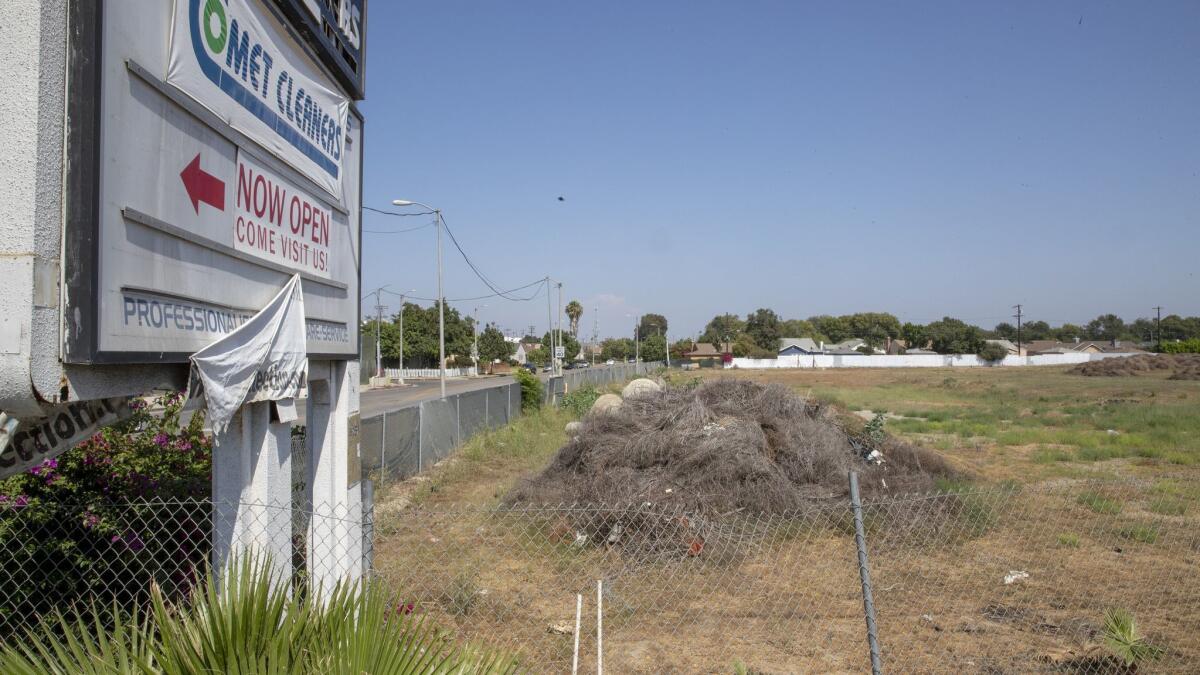A project could bring South L.A. hundreds of new homes. But critics fear rising rents
The real estate project known as District Square has had a decadelong run of bad luck.
Construction of the project in South Los Angeles has been repeatedly delayed. The developers, who were provided millions of dollars in federal loans, have received multiple default notices from the city. And Arman Gabay, one of the businessmen who conceived the project, was arrested last year on bribery and wire fraud charges. He has pleaded not guilty.
District Square’s fortunes could turn around on Tuesday, when the South Los Angeles Area Planning Commission is scheduled to take up the 577-unit residential project. But the six-story development still faces a key obstacle: activists who are frustrated that the developers have not set aside any units as affordable for low-income families.
“We’d have issues with any project ... that has this many market-rate units in a community that’s low income,” said Damien Goodmon, executive director of the Crenshaw Subway Coalition, a group focused on fighting gentrification. “But the fact that there are no affordable units is even more egregious.”
Goodmon contends that District Square, which is planned at the corner of Crenshaw and Obama boulevards, will inspire other landlords to increase their rents, forcing out black and Latino households.
If the commission signs off on the project, Council President Herb Wesson should take it up on the council floor and ensure that affordable housing is built at that location, Goodmon said.
Edward Johnson, a Wesson spokesman, had no comment Monday when contacted by The Times. Stacey Brenner, who is listed in city documents as a consultant for developer Mark Gabay and the company District Square LLC, did not respond to multiple messages.
Planning officials, for their part, have informed the commission that they do not expect any displacement, since District Square is slated to be built on an empty lot.
“There is no substantial evidence that the approval of the project resulted in intentional discrimination against a protected class of low-income residents,” officials from the planning department said in their report to the commission.
City officials have determined that District Square is exempt from the state’s environmental law, in large part because it’s near an Expo light rail station and complies with specific planning rules for the surrounding neighborhood.
Goodmon and one of the project’s neighbors have submitted an appeal of the planning department’s decision to the area planning commission, which is made up of appointees of Mayor Eric Garcetti.
The debate over District Square comes six months after the City Council approved a 725-unit residential project in Chinatown that had no affordable units. Renters rights’ groups opposed that development, saying it would spur other landlords in that neigbhorhood to increase rents in their own buildings.
Cynthia Strathmann, executive director of the tenant advocacy group Strategic Actions for a Just Economy, said South Los Angeles does need more housing — but at a price that residents can afford.

A project filled exclusively with market-rate apartments “can drive up rents and have an indirect displacement effect and make housing even less affordable for people in the community,” she said.
Despite those concerns, business leaders along the Crenshaw Corridor have lined up behind District Square. Armen D. Ross, president and chief executive of the Crenshaw Chamber of Commerce, said it will create a new gathering place on the boulevard and help the area benefit from the staging of the Olympic Games in L.A. in 2028.
District Square “certainly will become a cultural destination attraction,” Ross wrote in a letter to the city.
District Square has been redesigned dramatically since it was first considered by the council. When it was approved by the council in 2010, it was planned as two-story shopping center — one that would house a Target store, Ralphs supermarket and a handful of retail chains. Wesson and his colleagues approved more than $26 million in financial assistance for the project that same year.
Target and Ralphs dropped out and Wesson, looking to rescue the development, backed additional loans for District Square. One Wesson staffer, who happened to be Gabay’s brother-in-law, worked on a plan to tap the city’s parking meter funds — an idea that was later abandoned.
Wesson later told The Times that the staffer was taken off the project after he learned of the familial connection.
By 2018, the city’s Economic and Workforce Development Department had sent the developers seven default notices, saying the developers had failed to comply with the terms of the loans. Two are still outstanding, according to a department official.
Meanwhile, staffers in Garcetti’s office worked with the developers on redesigning the project, increasing its height and adding hundreds of homes.
According to a report to the commission, the project will now reach 75 feet. District Square will also have 934 parking spaces and roughly 93,000 square feet of commercial space, the report said.
More to Read
Sign up for Essential California
The most important California stories and recommendations in your inbox every morning.
You may occasionally receive promotional content from the Los Angeles Times.











